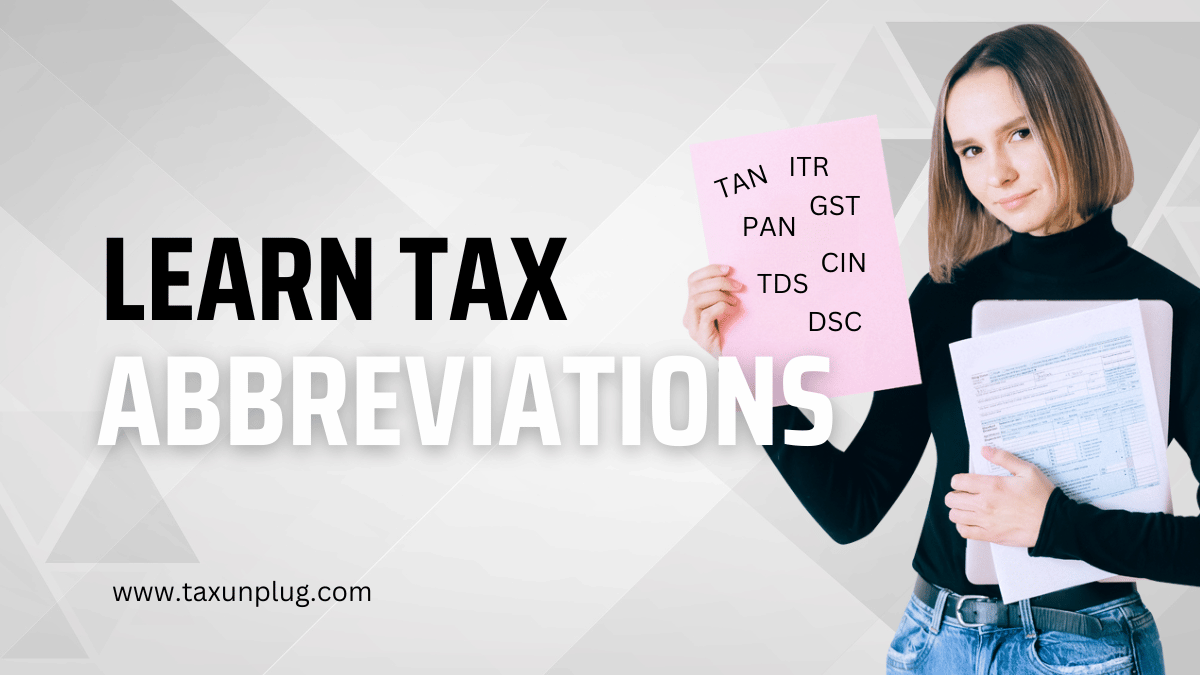Learn Tax Abbreviations:
Understanding tax abbreviations is crucial for anyone dealing with taxes in India. Whether you are a salaried employee, a business owner, or just starting out, this guide from TaxUnplug will simplify complex tax jargon for you.
Why Learn Tax Abbreviations?
Tax abbreviations can often seem confusing, but they are used frequently in documents and forms. Knowing what they mean will help you:
- Understand your tax obligations.
- File your tax returns accurately.
- Communicate effectively with tax professionals.
Common Tax Abbreviations in India
1. PAN (Permanent Account Number)
PAN is a unique 10-character alphanumeric identifier issued to all taxpayers in India. It helps track financial transactions and prevents tax evasion.
2. GST (Goods and Services Tax)
GST is a comprehensive, multi-stage, destination-based tax that is levied on every value addition. It has replaced many indirect taxes in India.
3. TAN (Tax Deduction and Collection Account Number)
TAN is required by individuals responsible for deducting or collecting tax at source. It is a 10-digit alphanumeric number issued by the Income Tax Department.
4. TDS (Tax Deducted at Source)
TDS is a method of collecting income tax in India, under which a certain percentage is deducted from payments such as salary, interest, or rent.
5. ITR (Income Tax Return)
ITR is a form where taxpayers declare their income, deductions, and tax payments. There are different types of ITR forms depending on the source of income.
6. CIN (Corporate Identification Number)
CIN is a unique identification number assigned to companies registered in India. It helps in tracking the company’s details and compliances.
7. DSC (Digital Signature Certificate)
DSC is a secure digital key that certifies the identity of the holder. It is used to sign electronic documents and is mandatory for filing income tax returns electronically.
8. DIN (Director Identification Number)
DIN is a unique identification number allotted to individuals who wish to become or are already directors of a company. It is mandatory for directors.

Learn Tax Abbreviations
Here are the 50 Most Used Tax Abbreviations
- GST – Goods and Services Tax
- PAN – Permanent Account Number
- TAN – Tax Deduction and Collection Account Number
- TIN – Taxpayer Identification Number
- CST – Central Sales Tax
- VAT – Value Added Tax
- ITR – Income Tax Return
- TDS – Tax Deducted at Source
- TCS – Tax Collected at Source
- NSDL – National Securities Depository Limited
- CBDT – Central Board of Direct Taxes
- CBIC – Central Board of Indirect Taxes and Customs
- ICDS – Income Computation and Disclosure Standards
- DTA – Double Taxation Agreement
- MAT – Minimum Alternate Tax
- GSTIN – Goods and Services Tax Identification Number
- HSN – Harmonized System of Nomenclature
- SAC – Services Accounting Code
- GSTR – GST Return
- EVC – Electronic Verification Code
- ITAT – Income Tax Appellate Tribunal
- SEZ – Special Economic Zone
- FTP – Foreign Trade Policy
- DTAA – Double Taxation Avoidance Agreement
- NRI – Non-Resident Indian
- LCIT – Large Taxpayer Unit
- FY – Financial Year
- AY – Assessment Year
- IEC – Importer Exporter Code
- EPF – Employees’ Provident Fund
- ESIC – Employees’ State Insurance Corporation
- RBI – Reserve Bank of India
- SFT – Statement of Financial Transactions
- HUF – Hindu Undivided Family
- LLP – Limited Liability Partnership
- GSTP – GST Practitioner
- AR – Authorized Representative
- AP – Authorized Person
- AE – Associated Enterprise
- BEPS – Base Erosion and Profit Shifting
- POEM – Place of Effective Management
- GAAR – General Anti-Avoidance Rule
- ICAI – Institute of Chartered Accountants of India
- ICSI – Institute of Company Secretaries of India
- CEA – Central Excise Act
- CMA – Cost and Management Accountant
- CENVAT – Central Value Added Tax
- SAF – Safe Harbor Rule
- TRC – Tax Residency Certificate
- UIN – Unique Identification Number
How to Remember These Abbreviations?
- Create flashcards with the abbreviation on one side and its full form and meaning on the other.
- Use mnemonic devices to create associations.
- Regularly review and use these abbreviations in real-life scenarios.
Frequently Asked Questions (Learn Tax Abbreviations)
1. What is the importance of a PAN?
PAN is essential for all financial transactions and helps the government track tax payments.
2. How does GST impact consumers?
GST simplifies the tax structure by combining various indirect taxes into one, which can reduce the overall tax burden on goods and services.
3. Who needs a TAN?
TAN is required for all individuals or entities responsible for deducting or collecting tax at source.
4. Can I file my ITR without a DSC?
Yes, individual taxpayers can file their ITR without a DSC, but companies and certain taxpayers must use a DSC.
5. What is the difference between PAN and TAN?
- PAN: Permanent Account Number is an alphanumeric identifier for all taxpayers.
- TAN: Tax Deduction and Collection Account Number is used by entities deducting or collecting tax at source.
6. How is GSTIN different from GST?
- GST: Goods and Services Tax is the tax itself.
- GSTIN: GST Identification Number is a unique number assigned to each taxpayer registered under GST.
7. What is the purpose of HSN and SAC codes?
- HSN: Harmonized System of Nomenclature is used for classifying goods.
- SAC: Services Accounting Code is used for classifying services under GST.
Understanding tax abbreviations can significantly ease your tax filing process. Stay informed and make your tax journey smoother with TaxUnplug’s comprehensive guide.

